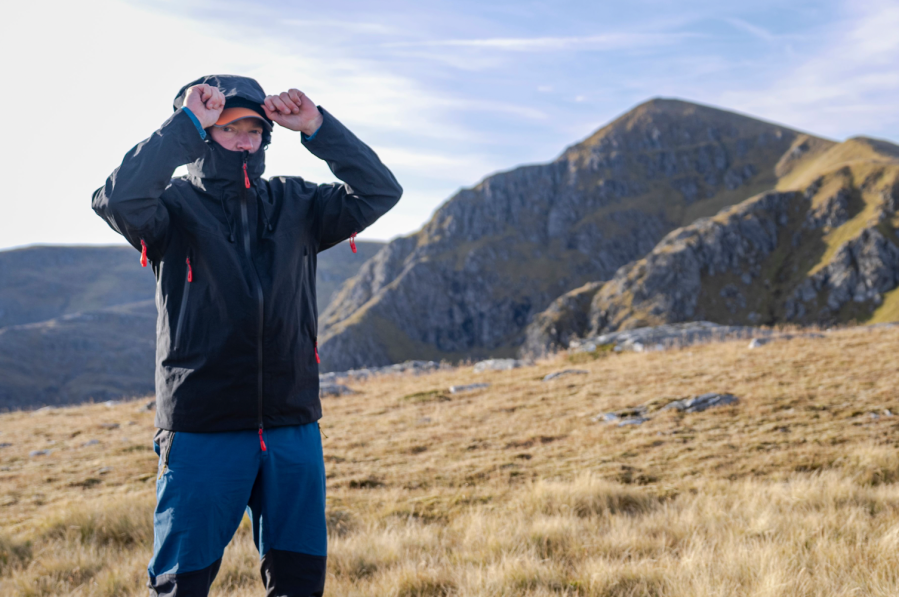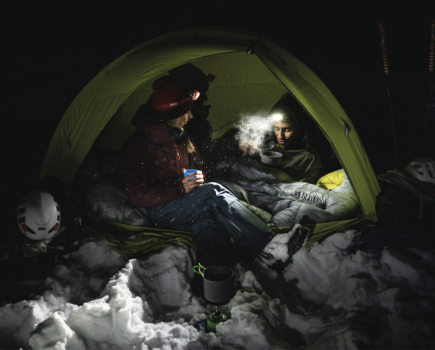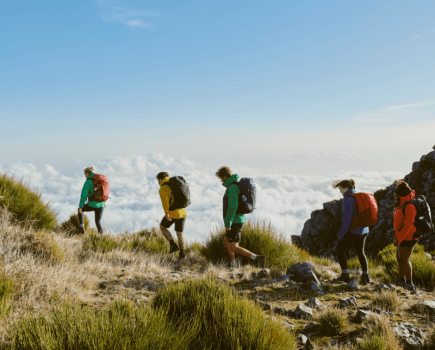Staying dry in unpredictable conditions is critical for comfort and safety, and a decent waterproof jacket is your best bet. However, with so many rain coats on the market, picking the correct one for you might be challenging. Some of the costs are really shocking. To assist we have compiled a list of the top budget waterproofs to consider before buying your next hardshell. We’ve curated a list of the best budget waterproof jackets from reputable companies that cost under $250 / £200. They are all waterproof and breathable, well-designed, and made from good quality materials.
Main image: Scottish alpine ready, but on a budget with Highlander | Credit: David Lintern
The lowest budget hardshell jackets will tend to be two-layer ones. These will have an outer fabric, a waterproof membrane and then an internal mesh to protect the membrane. These might be waterproof but they’ll often be quite heavy and and also not very breathable.
Next you have 2.5-layer jackets. These have a shell fabric, a membrane and then an inner layer, usually made from a printed or sprayed on PU. These will often be lightweight and breathable and tend to make good jackets for fast tempo activity. A lot of the jackets in this round-up are 2.5 layer designs that are suitable for three-season use.
Then there are 3-layer jackets. These have an outer fabric and an inner backer fabric with a membrane sandwiched between them. Gore-Tex Pro and many standard Gore-Tex jackets will be 3-layer designs. These types of jackets will tend to cost more but they’ll offer higher levels of waterproofing, breathability, durability and longevity.
Other signs of a good jacket include the extent of adjustment at the hood and at the hem and cuffs, the amount of pockets, whether the zips are waterproof and things like pit zips, RECCO reflectors and two-way zip pulls.
Why you can trust The Great Outdoors
The Great Outdoors is Britain’s original mountain magazine. We have been helping people to explore from sea to summit, valley to mountain top for more than 40 years. We’re here to help you make the most of your time outside. With over 200 years’ experience between them, our gear testing team is the most experienced in Britain, including mountain leaders and instructors, wildlife photographers and rangers, scramblers, hikers, bikers, boaters and runners. Our gear reviews are renowned for their rigour, trustworthiness and independence. Find our more about how we test.
Our budget waterproof jacket picks
| Quick List |
|---|
| Greener Choice: Alpkit Sigma – buy now from Alpkit |
| Best Value for women: Harrier Exmoor – buy now from Harrier |
| Best Value for men: Highlander Munro V2 – buy now from Highlander |
Greener Choice
Alpkit Sigma
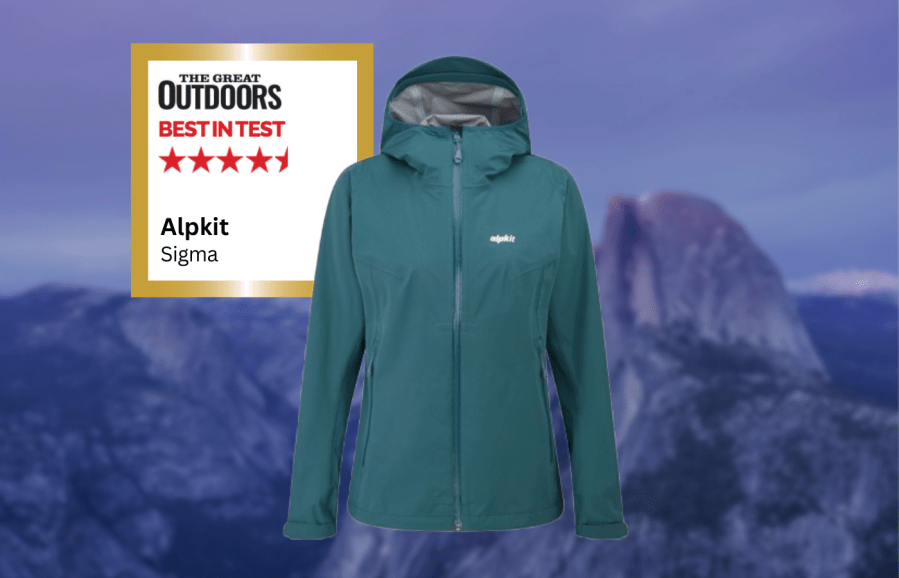
Kirsty Pallas’ Best in Test & Greener Choice
The Sigma should work for many people and activities due to its light weight and its price. The eco credentials are an added bonus.- low profile fit
- neat cuffs and hood
- Pockets sit under rucksack or harness waist strap
| Quick specs |
|---|
| Price: $220 / £169.99 (available from Alpkit) |
| Weight: 340g (size 10) |
| Materials: 100% recycled polyester with PFC free DWR coating |
| Hood: Wired peak, volume adjuster, elasticated sides |
| Front Closure: YKK Aquaguard zip with inner storm flap |
| Underarm/Side Zips: No |
| Pockets: 2 large hand pockets |
| Hem: Drawcord adjustment |
| Cuffs: Elasticated with velcro |
| Sizes: 6 – 20 |
| Men’s version: Yes |
| alpkit.com |
The Sigma is a nice three season jacket from Alpkit, and highlights their commitment to sustainability by not only using 100% recycled materials, but making sure they can all be recycled again at the end of the jacket’s life. I really like the fit and feel of the jacket. It’s neat without being overly tight, and it has a flexible feel, in part due to not using a Gore-Tex membrane. It dealt with all rain I experienced without issue and, as with most modern fabrics, keeping it clean will help it to continue to do so.
The price point and lighter weight mean it should work for a wide range of people and for a range of activities. I plan to use it climbing, walking, mountaineering and biking, all of which it will manage with ease.
Read more: Kirsty’s full Alpkit Sigma review
Best value (women's)
Harrier Exmoor
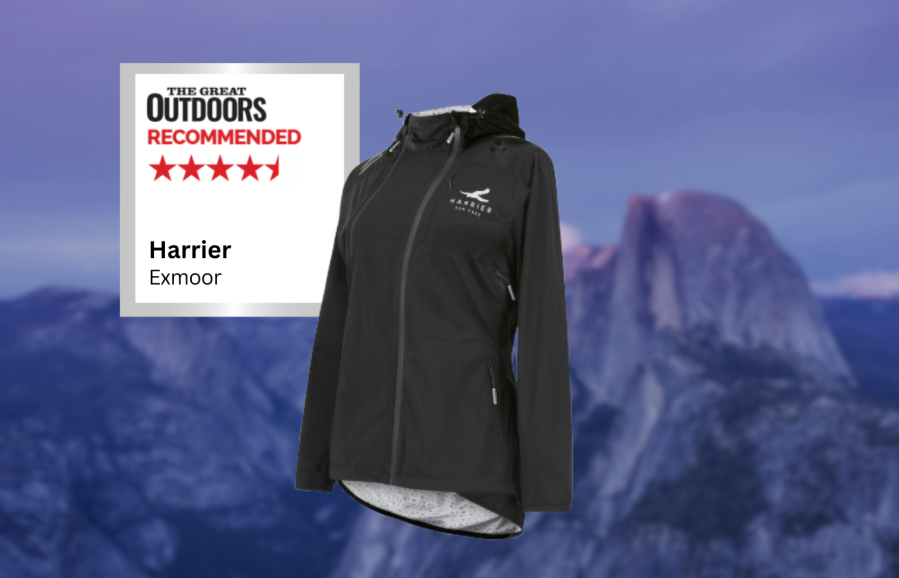
Kirsty Pallas’ Best Value
I’ve enjoyed wearing the Exmoor as it doesn’t feel like a waterproof at all. It’s soft, flexible and quiet.- soft feel
- ventilation options
- waterproofed rated to moderate rain
| Quick specs |
|---|
| Price: $122 / £94.99 (available from Harrier) |
| Weight: 309g (size XS) |
| Materials: 100% polyester |
| Hood: Stiffened peak with volume adjusters at back and sides |
| Front Closure: Offset front zip with internal storm flap and studs |
| Underarm/Side Zips: Yes, small pit zips |
| Pockets: 2 hand pockets, 1 back pocket, 1 chest pocket |
| Hem: Drawcord adjustment with an inner elasticated skirt |
| Cuffs: Elasticated with thumb loops |
| Sizes: XS – XL |
| Men’s version: Yes |
| harrierrunfree.co.uk |
The Harrier Exmoor is a trail running jacket and I’m about as far from a trail runner as it gets, so bear with me! I wasn’t sure whether this would work for me, but the Exmoor almost got the Best in Test. I’ve really enjoyed wearing it as it doesn’t feel like a waterproof at all. It’s soft, flexible and quiet. It’s a good fit, and I can still just about get a duvet jacket on underneath.
The only slight drawback is the waterproof rating. I understand that it’s a compromise for a running jacket, so for me this is a jacket for lighter summer rain and drizzle. There are a couple of other nifty features like being able to pack it away into its own back pocket, and it can also be used as a bumbag in itself.
Read more: Kirsty’s full Harrier Exmoor review
Best value (men's)
Highlander Munro V2
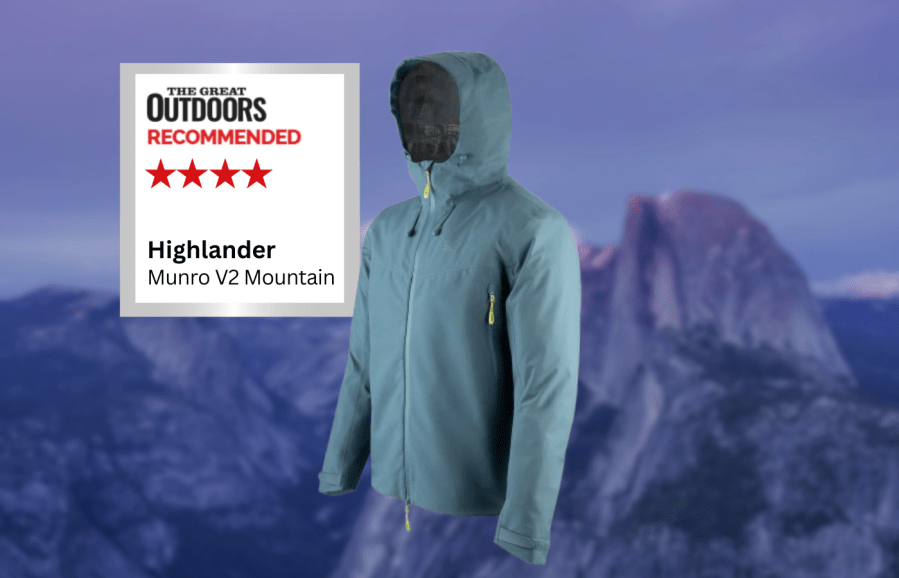
Chris Townsend’s Best Value
The Munro Jacket is comfortable and I’ve been happy wearing it in storms. It may be inexpensive but it doesn’t feel like a budget garment.- hood
- cost
- quite heavy
- no women’s version
| Quick specs |
|---|
| Price: $232 / £180 (available from Highlander) |
| Weight: 580g (L) |
| Materials: 3 – layer PROT3X PFC Free polyester |
| Hood: front and rear adjustment, wired stiffened peak |
| Front Closure: YKK waterproof zip, inner flap |
| Underarm/Side Zips: two-way YKK zips |
| Pockets: two harness/hipbelt compatible, 1 inner |
| Hem: Drawcord adjustment |
| Cuffs: cuffs |
| Sizes: S – 2XL |
| Women’s version: no |
| highlander-outdoor.com |
The Highlander Munro V2 Mountain Jacket is a fully specified jacket suitable for year-round use at a low cost, making it superb value for money. The hydrostatic head rating of 20,000mm (the height of a column of water that can stand on the fabric before it leaks) compares well with that of many far more expensive jackets. In heavy rain it has proved fully waterproof. Breathability however is on the low side at 15,000 MVTR (Moisture Vapour Transmission Rate). Top end jackets are usually at least 20,000. In practice I have found condensation appearing inside a bit sooner than with the other jackets tested but it’s not been a problem. A main reason for this is that the Munro has long underarm zips so damp air can be easily expelled. This is an excellent feature, especially given the price.
The Munro Jacket is comfortable and I’ve been happy wearing it in storms. It may be inexpensive but it doesn’t feel like a budget garment. It is quite heavy, the heaviest jacket tested, and maybe overkill for summer backpacking, but at the same time it’s adequate for winter mountain use.
Read more: Chris’ full Highlander Munro V2 review
Berghaus Paclite Dynak Gore-Tex
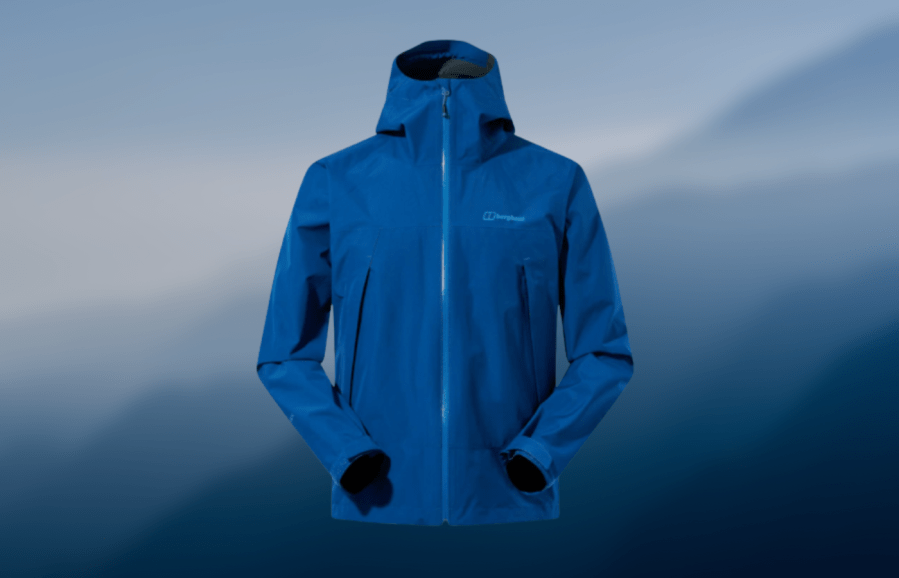
Lucy Wallace’s verdict
The overall fit of this rain jacket is fairly relaxed, especially compared to trimmer fitting shells, with room for a layer or two underneath.- Packable
- Climate friendly
- Hood minimalist
| Quick specs | |
|---|---|
| Price | £170 |
| Weight | 292g (10) |
| Materials | 2-layer Gore-Tex Paclite, taped seams |
| Hood | stiffened, one adjuster |
| Sizes | women UK8-18 (men XS-XXL) |
| Men’s version | Yes |
£170 is excellent value for a rain jacket of this calibre. It’s light, it’s durable, it’s breathable and protective and it’s well furnished with features – there’s a lot to like here.
It’s not quite as nice to wear as a 3-layer shell if you’re forced to keep it on for extended periods but the inner face does at least have a built-in carbon backer instead of a clingy drop liner or printed ‘half-layer’ like many cheaper 2.5-layer PU-based shells and that means it provides reasonable comfort levels. We found that it only started to feel a bit clammy when really working hard uphill.
The one-way, water-resistant main zip has an internal storm flap and a comfortable microfibre chin guard. The two hand pockets are a decent size and are placed high enough to stay out of the way of a backpack hip belt. The pocket zips aren’t watertight but they do have double storm flaps – so there’s peace of mind there.
The overall fit of this hardshell jacket is fairly relaxed, especially compared to trimmer fitting shells, with room for a layer or two underneath.
Read our full Berghaus Paclite Dynak Gore-Tex review – tested in 2023
Available at: berghaus.com
RAB Arc Eco

David Lintern’s verdict
Perhaps not a rain jacket for the depths of winter but it is a light, simple, cheap and more environmentally-friendly option for backpacking and hillwalking.- Eco credentials
- Great all-rounder
- Cost
- Needs more pockets
| Quick specs | |
|---|---|
| Price | $235 | £200 |
| Weight | 436g |
| Materials | 3-layer Pertex Shield recycled polyester ‘Revolve’, recycled inner, PFC-free DWR |
| Features | Part-wired 3-way adjustable hood, 2 large pockets |
| Sizes | S-XXL |
| Women’s version | Yes |
The Rab Arc Eco was given Gold in our TGO awards for sustainability and it has really stood out from the other men’s waterproofs here too. On test since last autumn, the fully recycled fabric has so far resisted wear and tear, with the 20,000 hydrostatic head and 15,000 MVTR (breathability rating), continuing to keep us completely dry.
Our tester found the cut of the jacket is quite long, and perhaps overly roomy at the chest, but this does at least allow for layering. The sleeves are Velcro-adjusted, and the hem adjusted by two toggles. As for pockets, there are only two very large handwarmers, situated just high enough to be useable whilst wearing a rucksack.
Perhaps not a rain jacket for the depths of winter but it is a light, simple, cheap and more environmentally-friendly option for backpacking and hillwalking.
Read our David Lintern’s full Rab Arc Eco review – tested in 2023
How we tested
Chris tested his jackets on day walks and multi day trips in the Scottish Highlands from spring 2024 through to early 2025. He is short and mostly wears a size large. Conditions included heavy rain, soaking drizzle, blizzards, and ferocious winds.
Kirsty tested these jackets through Autumn and early winter in Scotland while hillwalking, biking and mountaineering in a mix of rain, snow and even some sunshine. Kirsty is a short size 8-10 and was aiming to get several layers under each jacket.
Additional 2023/24 testing from David Lintern and Lucy Wallace has been included. All weights are taken from the reviewer’s own scales. Most of the jackets tested are three-season hardshells but there are also options that will suit tough winter trips in snow too. The jackets have been chosen on the basis of their protection, breathability and durability, with weight, packability, features, fit sustainability and value influencing our decisions too.
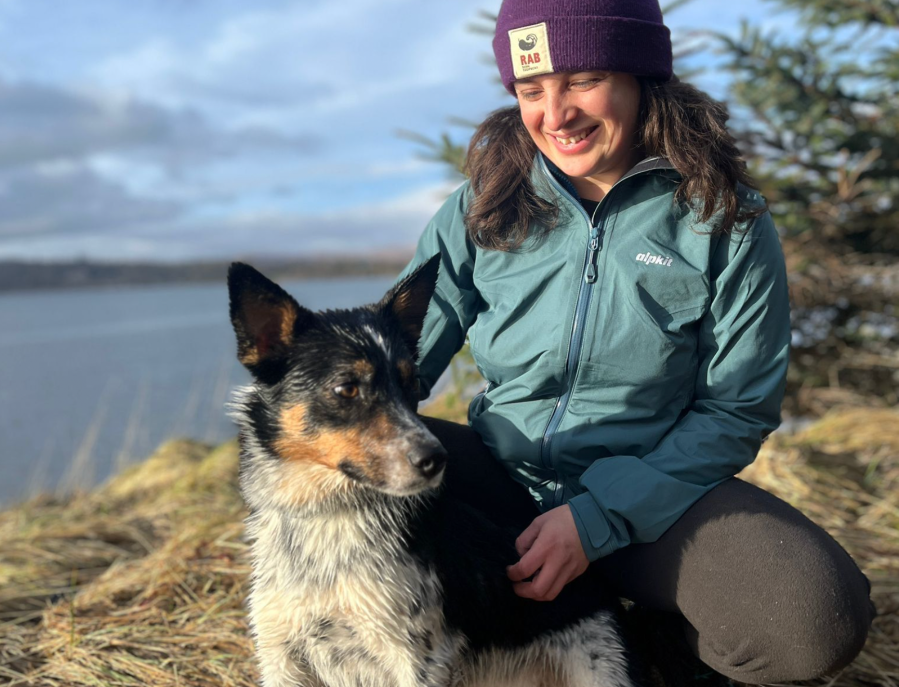
How to choose the best waterproof jacket for you
Finding the right waterproof jacket can greatly enhance your comfort and performance in adverse weather conditions. It’s also absolutely crucial from a safety perspective. First and foremost, the main things to assess when choosing a rain jacket are the levels of waterproofness and breathability as these determine its ability to keep you dry while allowing moisture to escape. Additionally, consider the hardshell jacket’s durability, weight, and packability to match your intended activities and environment. If you like to move fast and light, for instance, then a lightweight 2.5-layer shell that’s light on features will be best for you. Conversely, if you’re into your winter mountaineering then you’ll want a more durable shell – 3-layer perhaps – with pockets and lots of adjustment.
Pay attention to features like hood design: is there adjustment so that it will hold in high winds? And pocket placement: will they be accessible when you’re wearing a baclpack with a hipbelt? You’ll also want to take into account the jacket’s fit and sizing to ensure optimal comfort and freedom of movement – many of our full individual jacket reviews will specify whether a jacket is true to size or not. If we don’t specify in the review, please feel free to get in touch with us directly to ask.
Finally there’s the sustainability side of things. If you’re conscious of the environmental impact of products, check whether any recycled materials are present and also whether the materials can go on to be recycled when the jacket comes to the end of its life. Some jackets these days still come with PFCs. These are water resistant chemicals that often escape through our washing machines and into the world’s water supplies where they stay for a very long time. Studies have found these in the world’s deepest oceans and even on the summit of Everest!
Fabric
The fabric determines how ‘breathable’ a garment will be. All waterproof fabrics are fully waterproof regardless of cost. Thicker fabrics give better protection in winter weather.
Construction
Waterproof fabrics are made up of layers of material. The most durable construction is three-layer in which the waterproof layer is sandwiched between the face fabric and an inner layer.
Hood
Hoods should be easily adjusted and move with your head. A wired or stiffened peak is useful in wind driven rain and snow. Helmet-compatible hoods should have volume adjusters so they can be reduced in size without affecting your vision for non-helmet wear.
Front Closure
Water-resistant zips are now standard. These are not fully waterproof in driving rain and should have an inner flap to repel any rain that gets through.
Ventilation
Underarm/side zips can be awkward to use but do allow good ventilation. They can often be used when the front zip has to be closed due to rain or snow. Zips that curve under the armpits are effective but the most difficult to adjust. Side zips that run from the armpit down the jacket are much easier to use.
Cuffs
Cuffs that can be opened wide are good for ventilation in the arms. Elasticised and narrow cuffs can lead to sweaty wrists.
Pockets
Whilst not essential pockets that are accessible when wearing a rucksack hipbelt are useful for items like compass, phone, snacks, map, hat and gloves.
DWR
The durable water repellency treatment (DWR) makes water bead and run off fabrics. In time this degrades and needs to be restored with a wash-in or spray-on product. The DWR does not affect the waterproofness of a garment but does reduce the breathability when it wears off gets dirty so you get more condensation inside. The DWR treatment used for many decades is being phased out as it contains environmentally damaging PFCs. Unfortunately, PFC-free DWRs do not last as long so garments need washing and reproofing more often.
Fit
For the most efficient breathability, the best waterproof jackets should fit fairly closely. At the same time, they shouldn’t be so tight that they restrict movement. And a rain jacket should fit comfortably over all the layers you might need to wear underneath it. Size labels should be taken as a guide only – they’re not consistent between makes.
Waterpoofing, breathability, adjustment, fit, features, sustainability and of course price. There’s a lot to consider, but by carefully weighing these up you can make a well-informed choice and invest in a waterproof shell that could serve you well and for a long, long time.
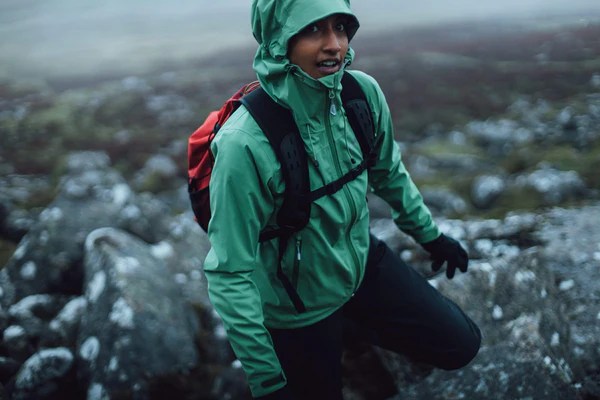
Measuring waterproofness and breathability
If you want to know how to stay dry when hiking in the rain, it’s important to consider a rain jacket’s waterproofness and breathability. If the weather is wet and warm, the fabric needs to have the capacity to let the moisture created by sweat to escape, otherwise you will end up damp inside the rain jacket. These days there are excellent waterproof and breathable membranes (which are also windproof). Most jackets also have a durable waterproof repellency (DWR) treatment added to the outer layer of fabric.
The waterproofness of a rain jacket is measured by determining the height of a column of water that the fabric can withstand before it starts to leak through. The resulting figure is known as the hydrostatic head (HH) and this is expressed in millimetres – the higher the number, the more waterproof the jacket is considered to be.
The breathability of waterproof garments is determined by the “Moisture Vapor Transmission Rate” (MVTR). This test measures the amount of water vapor that can pass through the jacket’s fabric over a given period of time. The unit of measurement used is typically grams per square meter per 24 hours (g/m²/24h). The higher the MVTR rating, the more breathable the jacket is considered to be.
Finally, colour choice may seem less important but a brighter shade will allow you to be more easily seen should you get into difficulty. Black, dark blues and greens blend in rather than stand out. Also, very light shades will show the dirt quickly.
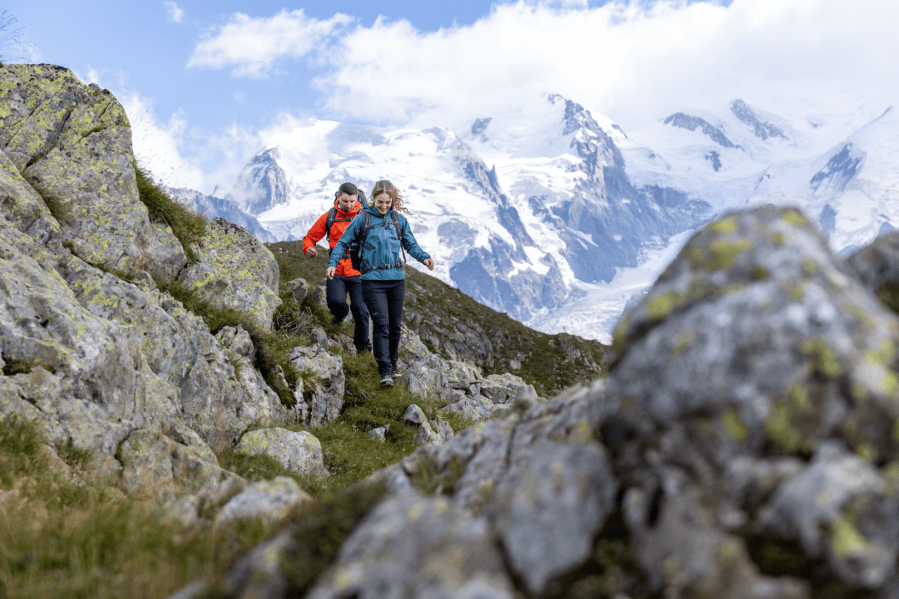
Waterproof fabrics and their ratings
- Hydroshell (Berghaus) – HH: 15,000 mm | MVTR: 20,000 g/m²/24h (official)
- Dermizax EV – HH: 25,000 mm | MVTR: 20,000 g/m²/24h (official)
- Unbranded (Alpkit Balance) – HH: 20,000 mm | MVTR: 20,000 g/m²/24h (official)
- Polartec Power Shield – HH: 20,000 mm | MVTR: 20,000 g/m²/24h (official)
- Futurelight (The North Face) – HH: Unknown | MVTR: 75,000 g/m²/24h (official)
- Pertex Shield – HH: 20,000 mm | MVTR: 20,000 g/m²/24h (estimated)
- H2No (Patagonia) – HH: 10,000mm to 20,000 mm | MVTR: 12,000 – 15,000 g/m²/24h (estimated)
- Omni-Tech (Columbia) – HH: 10,000 mm | MVTR: 10,000 g/m²/24h (estimated)
- eVent – HH: 30,000 | MVTR: 15,000 to 25,000 g/m²/24h (estimated)
- Gore-tex – HH: 28,000 mm | MVTR: 17,000 g/m²/24h (estimated)
- Gore-tec Paclite – HH: 28,000 mm | MVTR:15,000 g/m²/24h (estimated)
- Gore-tex Pro – HH 28,000 mm | MVTR: 25,000 g/m²/24h (estimated)
How to look after your waterproof jacket
Looking after waterproof jackets can be trickier than a normal piece of clothing; they require a certain amount of upkeep if they are to continue to keep you dry and perform well for a long time. Dirty rain jackets don’t let body moisture through very well, so you get damp from condensation building up inside the rain jacket as you sweat quicker. The Durable Water Repellency (DWR) treatment on the outside of hardshell jackets that causes rain to bead and run off rather than soak in can also wear off and need replacing over time. This also leads to condensation as the garment is then less breathable.
There are two main elements to waterproof jacket care: washing, and restoring the jacket’s DWR treatment. Our guide on how to look after your waterproof jacket will further help you to understand common problems with hardshells, rain jackets and how to manage them.
How to repair your waterproof
To repair a small hole or tear you will need:
- Duct tape
- Seam sealant
How to do it: Patch over with tape (do this on both sides if possible). Reinforce edges with seam sealant. You could also use a Gore-Tex repair kit. You can use duct tape on clothing and sleeping bags. I have down jackets and bags with duct tape patches that have been there for years). I’ve never had to repair a softshell jacket but if there was a big hole or rip I’d just stick duct tape on it. Of course, a hole in softshell or fleece is more significant compared to one in a waterproof.
Learn more about how to repair your waterproof jacket.

